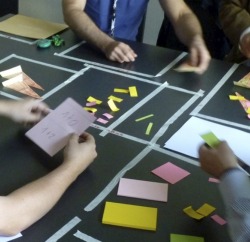Step 1: Define your target user experience
An engaging UX/UI doesn’t happen “auto-magically”. It requires a well defined and focused strategy that is linked to company core business objectives, ideally straight from business unit leaders (Sales, Marketing, Content, etc.). It is critical to work collaboratively with internal leaders to identify quantifiable user experience goals to the core goals for the application, web or mobile. It’s all about helping the product owners achieve value through a better experience to end users.
Once this is completed, build out an execution roadmap to support it. This is essential in focusing the budget, time and daily activities that actually move the needle for business. A good user experience strategy includes:
- Solid competitive landscape analysis and trends
- Business Intelligence – Analytics and data (data is power)
- User research (end user personas, journey maps)
- MVP Feature prioritization
- Rapid Prototyping and Design Schemes
Step 2: Integrate User Insight
Remember, companies are not designing for employees. A designer or UX engineer who thinks they know their audience without having conducted any research is a recipe for product disaster. Different end user groups have different ways of using web applications in general, and have varying needs and preferences for using such software. Embrace them and they will embrace your app. Ignore them and they will, rightfully, ignore your app.
It’s critical to conduct planning sessions and user ‘journey’ mapping and personas to transform time spent on research into key insight, and drive user-centered thinking across your organization.
Step 3: Build for Innovation and Simplicity. Simple is always better.
End user expectations require more than the static UI from five years ago. Today’s modern digital experiences are highly interactive and personalized. They deliver information, at the right time, to the right device — whenever and wherever the user wants it.
Additionally, today’s experiences require the use of touch, gestures, motion, and proximity — all delivered in the most unobtrusive and intuitive means possible. To be successful, the experience must be designed and evaluated according to the behaviors and habits of the end users.
Step 4: Fail fast and early
One of the most effective ways to your web app is engaging and successful is through prototyping and agile iterative testing. Rapid development prototypes allow product owners and development teams to simulate and evaluate the end-user experience without heavy investment, while also keeping product owner expectation setting in mind. Use prototypes to test early stages of all cycles of development from iteration 0 and beyond. It is a fast, low-risk method to assure you got it right before you build too much. Encourage your design team to fail early and fail fast. This nurtures creativity, innovation and progress. The critical element is to institutionalize the concept of rapid prototyping and testing with development teams, especially Dev, QA and Product teams.
Prototyping allows teams to visualize an experience, evaluate it, and iterate very quickly — to assure you got it right before you build.
Detailed design prototypes reduce the need for complex, written design specifications for developers (which can be ambiguous and out-dated material, anyway.)
Developers may be able to re-use HTML5 prototype code for the front-end design build-out, thus reducing time to market, reducing development cost, and reducing quality assurance testing.
Step 5: Collaborate with the extended team
Establishing quality processes and empowering cross-functional collaboration is key. Many non-functional components, like application speed and security, play a huge role in experience. It is important for product developers, business analysts, and technology leaders to work together to achieve the business goals.



Great write up, taking this right to my team in Colorado for a little retrospective!
Thanks!
_ JR